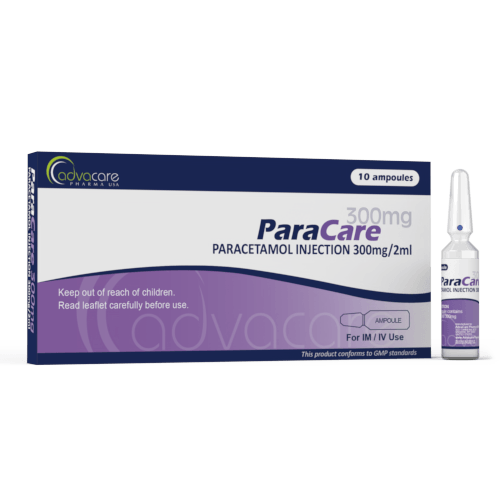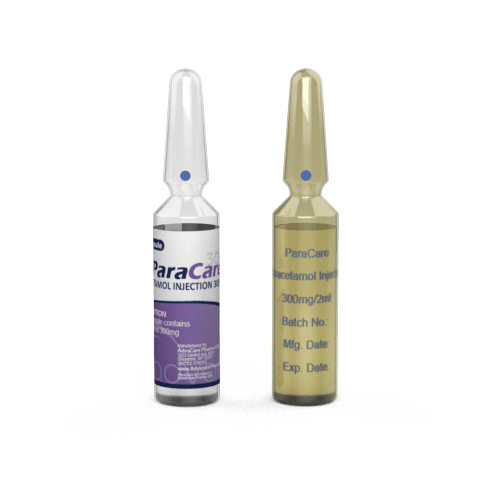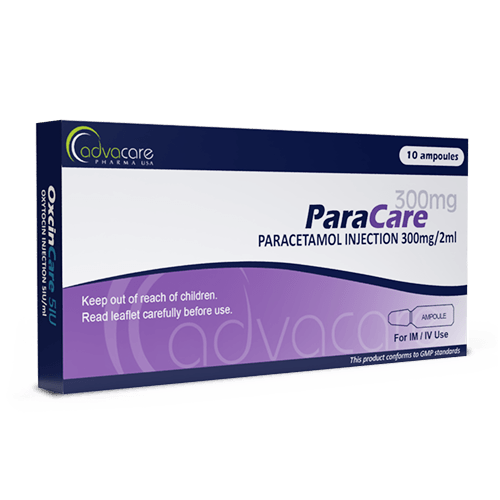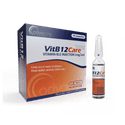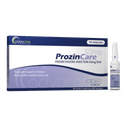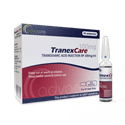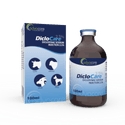- Home›
- Pharmaceuticals›
- Injections›
- Small Volume Injections›
- Paracetamol Injection
Paracetamol Injection
Dosage
Packaging
What is Paracetamol?
Active Ingredients: Paracetamol
Paracetamol Injection is a drug used for the short-term relief of mild to moderate pain. Injections are typically given when a patient is unable to take the oral form of this medication, such as after surgical procedures. An intravenous route is also recommended for emergency situations, like hyperthermia.
This medication can also be used to reduce fever in adults and children.
Paracetamol belongs to the classes of medications called analgesics (pain relievers) and antipyretics. It demonstrates a strong capacity for pain management but exhibits weak anti-inflammatory activity. Though it is unclear the exact site of action, the active ingredient may work by either inhibiting prostaglandin synthesis or by activating descending serotonergic pathways.
Paracetamol is thought to inhibit the cyclooxygenase (COX) pathways indirectly and exert central actions that ultimately alleviate pain symptoms. Its antipyretic effects are likely the result of its action at heat-regulating centers in the brain that result in peripheral vasodilation, sweating, and loss of body heat.
Paracetamol is also known by the name acetaminophen. It is the most commonly taken analgesic in the world and is produced in many different forms, including tablets, capsules, oral suspensions and syrups, and injections. It is recommended as a first-line therapy for pain conditions by the World Health Organization (WHO).
AdvaCare Pharma is a global supplier of Paracetamol Injections. AdvaCare excels at the distribution of high-quality, yet cost-effective, treatments. This medication is manufactured in our GMP-certified facilities located in China, India, and the USA.
Why are we a leading Paracetamol manufacturer?
AdvaCare Pharma, a US-owned pharmaceutical company, is a manufacturer of Paracetamol Injection with GMP-compliant manufacturing facilities located worldwide. We conduct frequent GMP, third-party and internal facility inspections to ensure that our manufactured injectable treatments exceed the stringent requirements of importing countries and our distributors.
As a renown Paracetamol manufacturer and global supplier of 120+ pharmaceutical injection products, our global reach extends to over 65 markets ensuring that pharmaceutical distributors, hospitals, pharmacies, NGOs and government institutions receive the quality-assured treatments they need.
Uses
What is Paracetamol used for?
It is used to treat pain caused by many conditions.
Paracetamol is indicated for the:
- Treatment of pain in adults and children 2 years or older.
- Treatment of moderate to severe pain with adjunctive opioid medications in adults and children 2 years or older.
- Reduction of fever in adults and children.
Injections of Paracetamol are typically given in emergency situations like hyperthermia or if a patient is unable to take the oral form of this medication, such as after a surgical procedure.
How are Paracetamol Injections used?
This medication is manufactured as a solution, which is to be administered intravenously (IV) by a healthcare professional.
What dose should be given and how often?
Recommended dosage guidelines may vary depending on age and weight:
- For patients weighing 50kg or more, the recommended dose is 1000mg, given every 6 hours or 650mg, given every 4 hours. Do not exceed a maximum dose of 1000mg/dose and 4000mg/day.
- For patients weighing less than 50kg, the recommended dose is 15mg/kg, given every 6 hours or 12.5mg/kg, given every 4 hours. Do not exceed a maximum dose of 15mg/kg/dose and 75mg/kg/day.
- For infants (29 days-2 years), the recommended dose is 15mg/kg, given every 6 hours. Do not exceed a maximum dose of 60mg/kg/day.
- For neonate patients (0-28 days), the recommended dose is 12.5mg/kg, given every 6 hours. Do not exceed a maximum dose of 50mg/kg/day.
IV infusions should be given over at least 15 minutes.
Refer to a doctor or pharmacist for guidelines on dosage.
Who can use Paracetamol?
Paracetamol Injection can be administered to adults, but caution is advised for specific groups of patients.
Pregnant IV paracetamol use during pregnancy has not been studied in animals. Animal studies of oral paracetamol use have found evidence of adverse fetal and maternal events, including liver and kidney necrosis. Human data spanning several decades of paracetamol use during pregnancy have not revealed definitive evidence of drug-associated risks of major birth defects, miscarriage, or other adverse maternal or fetal outcomes.
In animal studies, paracetamol administration was associated with reduced reproductive capacity of parental male and female animals, such as decreased litter sizes and delayed litter growth, abnormal sperm in their offspring, and reduced birth weights in the following (third) generation.
Nursing Paracetamol is excreted into human milk. The effects on nursing infants are unknown.
Caution should be exercised when administering paracetamol to nursing patients. Nursing infants should be closely monitored for any potential adverse effects. The benefits of breastfeeding, the potential patient benefits, and the potential infant risks should all be considered when considering paracetamol use while nursing.
Pediatric The recommendations for dosage adjustments for children are as follows:
- In patients < 2 years old, the efficacy of Paracetamol Injection for the treatment of acute pain has not been established.
- In patients < 2 years old, the efficacy and safety of Paracetamol Injection for the treatment of fever is supported by adequate and well-controlled studies.
Geriatric Studies have not found differences in paracetamol’s safety or efficacy in older adults (≥ 65 years) compared to younger adults. Age-related decreases in hepatic and renal function and an increased sensitivity to drugs should be considered when administering paracetamol to older patients. Dosage reductions and organ function monitoring may be necessary.
Other warnings
In patients with severe hepatic insufficiency or disease, paracetamol use is contraindicated. In patients with mild to moderate hepatic insufficiency, caution should be exercised, and dosage reductions may be necessary.
Doses exceeding the recommended daily limit may result in hepatic injury, severe hepatotoxicity, and death.
Do not exceed the maximum daily dose based on patient weight. Concomitant use with other medications containing paracetamol is contraindicated. Concomitant use of paracetamol with alcohol can increase the hepatotoxic potential of both agents.
Signs of hepatic injury that require medical attention are nausea, vomiting, loss of appetite, sweating, fatigue, jaundice (yellowing of the skin or eyes), dark urine, light-colored stool, pain in the upper abdominal area above the liver, and itching.
In patients with severe renal insufficiency, longer dosing intervals and reduced daily dosages may be necessary.
Hypersensitivity and anaphylaxis reactions have been reported with paracetamol use. Symptoms can include difficulty breathing, swelling of the face, mouth, or throat, rash, hives, and itchy skin. Rare, potentially fatal adverse skin reactions, including acute generalized exanthematous pustulosis (AGEP), Stevens-Johnson Syndrome (SJS), and toxic epidermal necrolysis (TEN), have been reported.
Paracetamol should be discontinued immediately at the first sign of skin rash, especially in the presence of blistering or peeling, or other signs of hypersensitivity reactions.
Paracetamol overdoses can cause liver damage or death. Early signs of overdose include loss of appetite, nausea, vomiting, sweating, and weakness. Symptoms that may develop later include yellowing of the skin or eyes (jaundice), dark urine, pain in the liver area (upper right abdomen).
Additional symptoms can include irritability, hunger, rapid heart rate, tremors, restlessness, difficulty concentrating, easy or unusual bruising, and purple or red pinpoint spots under the skin.
Paracetamol should be administered with caution in patients with hepatic impairment or active disease, alcohol use disorder, chronic malnutrition, severe hypovolemia, and severe renal impairment.
Paracetamol Injection should be prepared and administered with care to avoid dosing errors that could result in accidental overdose and death. Ensure that the dose in milligrams (mg) is not confused with milliliters (mL), the dosing is appropriate for the patient’s weight, infusion pumps are programmed properly, and the total daily dose of paracetamol from all sources does not exceed the maximum daily limit.
Paracetamol has been found to interfere with continuous glucose monitoring (CGM) sensors, resulting in falsely elevated blood glucose (BG) values when compared to BG meter values. This may have clinical consequences for patients with diabetes who are using CGM values instead of BG values and who are using CGM values in a closed-loop system for automated insulin delivery. The FDA currently recommends that BG values are used instead of CGM values when making insulin dosing decisions.
Cytochrome CYP2E1 inductors and inhibitors may impact paracetamol’s metabolism and increase its hepatotoxic potential. The clinical consequences of these effects have not been established.
Oral doses of 4000mg/day of paracetamol have been shown to increase international normalized ratio (INR) in some patients taking the anticoagulant sodium warfarin. Studies evaluating the short-term use of Paracetamol Injection have not been performed, and patients taking anticoagulants may warrant INR assessment while receiving Paracetamol Injections.
Side Effects
As with all pharmaceuticals, some unwanted effects can occur from the use of Paracetamol Injection.
Common side effects include, but may not be limited to:
- nausea
- constipation
- vomiting
- headache
- swelling near the injection site
- trouble sleeping
Serious side effects may include:
- signs of an allergic reaction (hives, difficulty breathing, swelling of face, lips, tongue, or throat)
- signs of a severe skin reaction
- fever, chest pain, or difficulty breathing
- signs of a liver problem
For a comprehensive understanding of all potential side effects, consult a medical professional.
If any symptoms persist or worsen, or you notice any other symptoms, please call your doctor.
Precautions
Do NOT use Paracetamol Injection if:
- You are allergic to paracetamol or any other ingredient.
- You have a medical history of liver dysfunction or disease.
- You have a history of alcohol use disorder.
- You have severe kidney problems.
Before treatment, consult your doctor regarding any medications you are taking to address potential drug interactions.
This medication may not be suitable for people with certain conditions, so it is important to consult with a doctor if you have any health conditions.
References
Randomized, controlled, multicentre clinical trial of the antipyretic effect of intravenous paracetamol in patients admitted to hospital with infection
This study evaluated a new ready-made infusion of paracetamol. It included 80 patients with a body temperature onset ≥38.5°C in the previous 24 h due to infection and they were randomized to a single administration of placebo (39 patients) or 1g paracetamol (41 patients), and their temperature was recorded at standard intervals.
Within the initial 6 hours, defervescence was attained in 15 (38.5%) patients administered a placebo, contrasting with 33 (80.5%) patients treated with 1g of paracetamol (P < 0.0001). The median time for defervescence with paracetamol 1g was 3 hours. Rescue medication was administered to 15 (38.5%) and five (12.2%) patients in the placebo and paracetamol groups, respectively (P = 0.007); among these, nine (60.0%) and two (40.0%) patients, respectively, achieved defervescence. There were no reports of drug-related adverse events.
The conclusion is that 1g paracetamol formulation has a rapid and sustainable antipyretic effect on fever due to infection and the efficacy is also dependent on hepatic metabolism.
You might be interested in...
Why AdvaCare Pharma?
As an industry leader, we are aware of our responsibility to provide affordable and sustainable solutions to improve healthcare worldwide.
